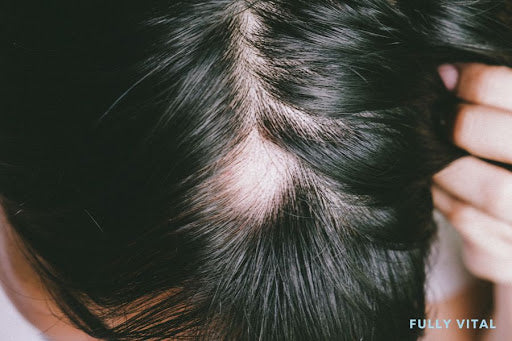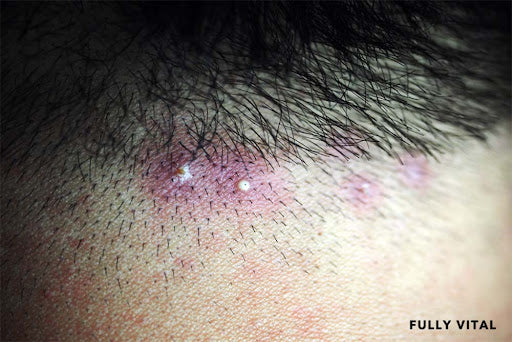
Triangular Alopecia: Understanding The Patchy Hair Loss Condition
Triangular alopecia is a hair loss condition that affects individuals of all hair types, including women.
This article will delve into what triangular alopecia is, why it's important to know about it, how it works, its benefits, potential downsides, and alternative options.
Our aim is to provide a conversational and informative guide to help women stimulate hair growth.
Let's get started!

I LOVE MY HAIR NOW
FullyVital hair serum and hair vitamins made tremendous improvements in my hair. I truly love my hair now.
Dorit S.,
What Is Triangular Alopecia?
Triangular alopecia, also known as temporal triangular alopecia or congenital triangular alopecia, is a condition characterized by a patchy hair loss pattern that forms a triangular shape.
This condition mainly affects the hairline region, specifically the temporal areas above the ears.1 It is often observed in infants and young children, although it can persist into adulthood in rare cases.

Why Is Awareness Of Triangular Alopecia Important?
Awareness of triangular alopecia is crucial because early detection and understanding of the condition can lead to effective treatment and prevention strategies.
By recognizing the signs and symptoms, individuals, especially women of all hair types, can address the condition promptly, stimulating hair growth and preventing further hair loss.
How Does Triangular Alopecia Occur?
Triangular alopecia occurs when hair follicles in the affected area stop producing hair, resulting in bald patches.
The underlying cause of this condition is still not fully understood, but it is believed to involve a combination of genetic and hormonal factors.
The affected hair follicles may have a reduced ability to regenerate and produce new hair.
What Are The Benefits Of Preventing Triangular Alopecia?
Preventing triangular alopecia can have several benefits, including:
Boosting confidence and self-esteem
By addressing the condition and promoting hair regrowth, individuals can feel more confident about their appearance.
Maintaining a full and healthy hairline
Preventing further hair loss helps maintain a natural and even hairline, enhancing overall aesthetics.
Avoiding potential psychological and emotional distress
Hair loss, especially in visible areas, can significantly impact individuals' emotional well-being.
Preventing triangular alopecia mitigates these potential distressing effects.
Are There Downsides In Triangular Alopecia Treatment?
While triangular alopecia treatment options exist, it's important to acknowledge that every approach has its pros and cons. Some downsides to consider include:
- Limited effectiveness: Treatment outcomes vary from person to person, and not everyone responds equally to interventions.
- Time and commitment: Successfully treating and managing triangular alopecia often requires consistent effort, patience, and dedication to the recommended treatment plan.
- Potential side effects: Some treatment options, such as medications or invasive procedures, may carry the risk of unwanted side effects. It is crucial to consult with a healthcare professional to weigh the benefits against the potential risks.
What Are The Alternatives To Triangular Alopecia?
If triangular alopecia treatment is not suitable or desired, there are alternative approaches that individuals can explore to address their concerns related to hair loss. These alternatives include:
- Hairstyling techniques: Skilled haircuts and styling methods can help create the illusion of a fuller hairline and camouflage the appearance of bald patches.
- Wigs or hairpieces: High-quality wigs or hairpieces can provide immediate coverage and boost confidence while allowing the natural hair to grow underneath.
- Non-invasive hair growth products: Topical solutions, shampoos, and scalp treatments formulated to stimulate hair growth can be used as an alternative or complementary option to conventional treatment methods.
What Are The Symptoms To Look Out For In Triangular Alopecia?
Recognizing the symptoms of triangular alopecia is essential for early detection and intervention.
Here are some common signs to be aware of:
Triangular or Oval Patch
Look for a distinct, symmetrical hair loss pattern above the temples, typically in a triangular or oval shape.
The affected area may have significantly thinner or absent hair.
Healthy Surrounding Hair
The hair surrounding the triangular or oval patch remains normal, providing contrast to the affected area.
Absence of Scalp Inflammation
Unlike other forms of hair loss, triangular alopecia typically does not involve redness, flakiness, or inflammation of the scalp.
How Is Triangular Alopecia Diagnosed?
Diagnosing triangular alopecia involves a thorough evaluation by a healthcare professional. During your visit, the healthcare provider may:
- Examine the Affected Area: They will visually assess the triangular or oval patch on your scalp, taking note of its size, shape, and hair density.
- Medical History: Provide a comprehensive medical history, including information about potential genetic predisposition, any related conditions, and hair care practices.
- Additional Tests: In some cases, the healthcare professional may conduct a scalp biopsy or other tests to rule out other underlying causes of hair loss or confirm the diagnosis of triangular alopecia.
What Causes Triangular Alopecia?
The exact causes of triangular alopecia are still not fully understood. However, research suggests that a combination of genetic and environmental factors contribute to its development. Factors that may play a role include:
- Genetic predisposition: Individuals with a family history of triangular alopecia are more likely to develop the condition.2
- Hormonal imbalances: Changes in hormone levels can impact hair growth and contribute to triangular alopecia.
- Trauma or injury to the scalp: Physical trauma or repeated tension on the affected area can trigger hair loss.
- Autoimmune disorders: Some autoimmune conditions may lead to hair loss, including triangular alopecia.
What Are The Surgical Options Available For Treating Triangular Alopecia?
In severe cases of triangular alopecia, where non-surgical treatments have proven ineffective, surgical options may be considered.
These procedures aim to restore hair growth in the affected area.
Here are a few common surgical options:
Hair Transplantation
Individual hair follicles from donor sites, usually the back of the head, are harvested and meticulously transplanted into the triangular alopecia patch.
Tissue Expansion
This technique involves inserting a balloon-like device beneath the scalp adjacent to the affected area.
Over time, the device is inflated to create excess skin, which is then used to cover the patch.3
Scalp Reduction
In some cases, scalp reduction surgery may be performed to remove the triangular alopecia patch, and the remaining scalp is then stretched to cover the area.
Experience The Power Of Healthy Hair With Fully Vital!At Fully Vital, we offer potent hair growth products that nourish, restore, and revitalize your hair. Our proven formulas are designed to promote regrowth, increase density, and enhance overall hair health. Key Features:
Join us on the journey to rediscover the vitality of your hair. Your hair deserves to look and feel its best, and we're here to make it happen! |
Final Thoughts On Triangular Alopecia
Understanding triangular alopecia is key for women of all hair types seeking to stimulate hair growth and maintain a healthy relationship with their locks.
By recognizing the causes, symptoms, and treatment options for this unique form of hair loss, we can take proactive steps towards prevention and regrowth.
Remember, whether you're experiencing triangular alopecia or any other hair concerns, it's crucial to consult with healthcare professionals and explore suitable solutions.
At Fully Vital, we are committed to providing a range of hair growth products that cater to your specific needs.
Our mission is to help women embrace their hair and foster a sense of confidence.
Together, let's embark on a journey of healthy hair, and remember that you are not alone – we are here to guide and support you every step of the way.
Frequently Asked Questions On Triangular Alopecia
Is triangular alopecia permanent?
Triangular alopecia is not always permanent.
With appropriate treatment, such as medications, topical therapies, or surgical interventions, it is possible to stimulate hair regrowth within the affected patch.
Can triangular alopecia spread?
No, triangular alopecia does not typically spread.
It remains confined to the triangular or oval patch on the scalp and does not extend to other areas of the scalp or body.
How is triangular alopecia different from other types of hair loss?
Triangular alopecia differs from other types of hair loss in terms of its specific pattern and location.
Unlike common forms of hair loss such as androgenetic alopecia or alopecia areata, triangular alopecia presents as a distinct triangular or oval patch above the temples.
The rest of the scalp usually maintains normal hair density.
Are there any known genetic factors that contribute to triangular alopecia?
Yes, genetic factors are believed to play a significant role in the development of triangular alopecia.
Studies suggest that specific genetic variations may increase the likelihood of developing this condition.
Can stress cause triangular alopecia?
While stress can contribute to hair loss, there is no definitive evidence linking stress as a direct cause of triangular alopecia.
However, ongoing research suggests that stress may exacerbate existing hair loss conditions and hinder the effectiveness of treatments.
Does triangular alopecia affect the entire scalp?
No, triangular alopecia is characterized by a distinct patch of hair loss localized above the temples. It does not affect the entire scalp.
The rest of the scalp usually maintains normal hair growth and density.
Is there a way to prevent triangular alopecia?
Preventing triangular alopecia entirely may not be possible since genetics and other factors contribute to its development.
However, early intervention and appropriate treatment may help slow down the progression and promote hair regrowth.
Is triangular alopecia contagious?
No, triangular alopecia is not contagious.
It is not caused by infectious agents and cannot be transmitted from person to person.
Does triangular alopecia lead to complete baldness?
Triangular alopecia does not typically lead to complete baldness.
The condition manifests as a distinct triangular or oval patch of hair loss, while the surrounding areas typically maintain normal hair growth.
Is hair loss in triangular alopecia sudden or gradual?
Hair loss in triangular alopecia is typically gradual. It is often a developmental condition that presents in childhood or early adolescence. As time progresses, hair follicles within the triangular or oval patch become miniaturized, leading to gradual thinning and hair loss.
Sources:
- Yin Li, V., & Yesudian, P. (2015). Congenital triangular alopecia. International Journal of Trichology, 7(2), 48. https://doi.org/10.4103/0974-7753.160089
- Patel, D. R., Tandel, J. J., & Nair, P. A. (2020). Congenital Triangular Alopecia - A Case Report. International Journal of Trichology, 12(2), 89–92. https://doi.org/10.4103/ijt.ijt_4_20
- Wagh, M. S., & Dixit, V. (2013). Tissue expansion: Concepts, techniques and unfavourable results. Indian Journal of Plastic Surgery : Official Publication of the Association of Plastic Surgeons of India, 46(2), 333–348. https://doi.org/10.4103/0970-0358.118612







